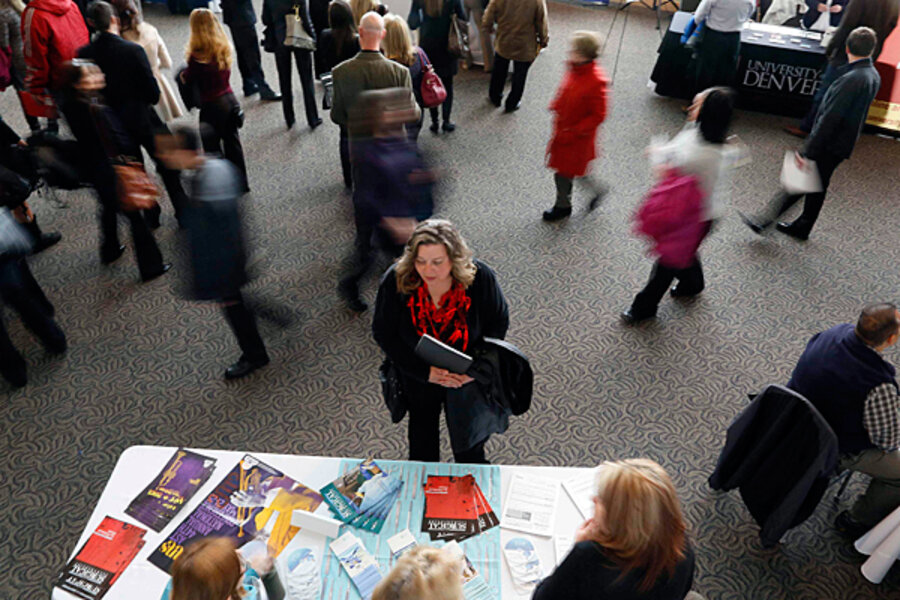US economy creates 175,000 jobs in May – too few to lower unemployment rate
Loading...
| New York
The US economy seems to be stuck in a rut: It’s growing, but not at a fast enough pace to make much of a dent in the unemployment rate.
In May, the economy added 175,000 new jobs, a moderate pace, but the unemployment rate rose to 7.6 percent from 7.5 percent, according to the Bureau of Labor Statistics.
Over the past three months, the economy has averaged a gain of 155,000 jobs – a rate that is far from the 200,000 a month that it needs to begin reducing the unemployment rate in a significant way.
“The economy is moving forward but going nowhere really fast,” says Mark Zandi, chief economist at Moody’s Analytics in West Chester, Pa. “It’s frustrating.”
Economists say the less-than-dynamic job market probably means that the Federal Reserve is not likely to taper off its monthly buying of securities, which has helped to buoy the housing market. On Friday, the stock market rallied sharply as traders assessed the jobs numbers with the Fed in mind. The Dow Jones Industrial Average was up 170 points to 15210 by midday.
“The rising unemployment rate makes a huge difference to the Fed,” says John Silvia, chief economist at the Wells Fargo Economics Group in Charlotte, N.C. “The Fed is not going to be tapering anything off in June.”
Behind the lackluster job growth is an economy that has several forces acting on it. Businesses, which had ramped up inventories earlier in the year, are now reducing inventories. This is a negative on economic growth, points out Dan Meckstroth, chief economist at the Manufacturers Alliance for Productivity and Innovation (MAPI) in Arlington, Va.
“They are letting production slow to demand,” says Mr. Meckstroth, who says this is one reason that manufacturing jobs shrank by 8,000 in May. “Production just got ahead of itself.”
At the same time, with low interest rates continuing to encourage home buyers to look at new homes, there have been job gains associated with housing. Last month produced, for example, 1,300 new jobs in wood products and 700 new jobs in the gypsum industry.
One of the strongest areas for job growth in May was the restaurant industry, which added 38,000 jobs. Mr. Zandi wonders if some of the hiring is by smaller restaurants that are trying to avoid paying for new health-care costs by moving full-time workers to part-time positions. “This may be health-care-reform related,” he says.
Separately, President Obama was in San Jose, Calif., on Friday to promote his health-care reform, which congressional Republicans want to repeal.
The threshold to qualify for health-care benefits is 30 hours a week, says Scott Brown, chief economist at Raymond James & Associates in St. Petersburg, Fla. “Firms are starting to cut hours now to 29-1/2,” he says, noting that in April, the labor statistics showed an overall reduction in hours worked. In May, hours worked were flat.
In the months ahead, hours worked will probably continue to shrink for another reason: An inability in Washington to reach agreement on the budget, resulting in automatic budget cuts called sequestration.
In July, the Defense Department will begin furloughs – a reduction in hours – for many employees. “This will show up in the hours worked,” Mr. Brown says. “We may see more job cuts in the summer months.”
Also, sequestration could have a ripple effect on jobs.
“Sequestration affected budget authority, not spending, so it impacts on the government’s ability to enter into a contract,” Meckstroth says. As the government cuts down on its ability to issue contracts, some contractors may have to lay off workers.
In the private sector, two of the brighter spots in May were an increase in temp workers (up 25,600) and people who work in retail (up 27,700). However, both of those sectors are relatively low-paying, writes Dean Baker of the Center for Economic and Policy Research in Washington.
Mr. Baker also observes that the bulk of the jobs added in May (some 203,000 out of 319,000 jobs) went to older workers, at least 55 years of age. Over the past year, out of 1.6 million jobs, some 1.2 million went to older workers.
A good part of the reason employers seem to be hiring more experienced people may be related to the steady increase in service-sector jobs such as retail and restaurants, along with older workers' interest in supplementing their retirement incomes.
“These are people who are in good shape, their minds are good, and the jobs are available,” Mr. Silvia says. “The economy is less focused on construction and hard work and more on services.”







